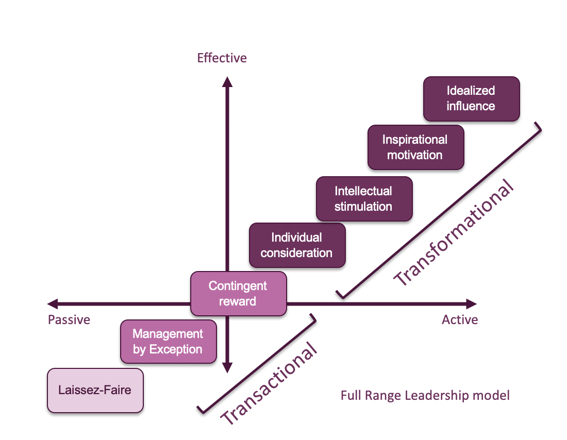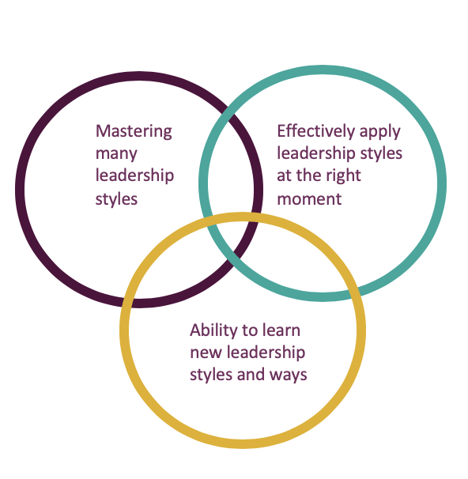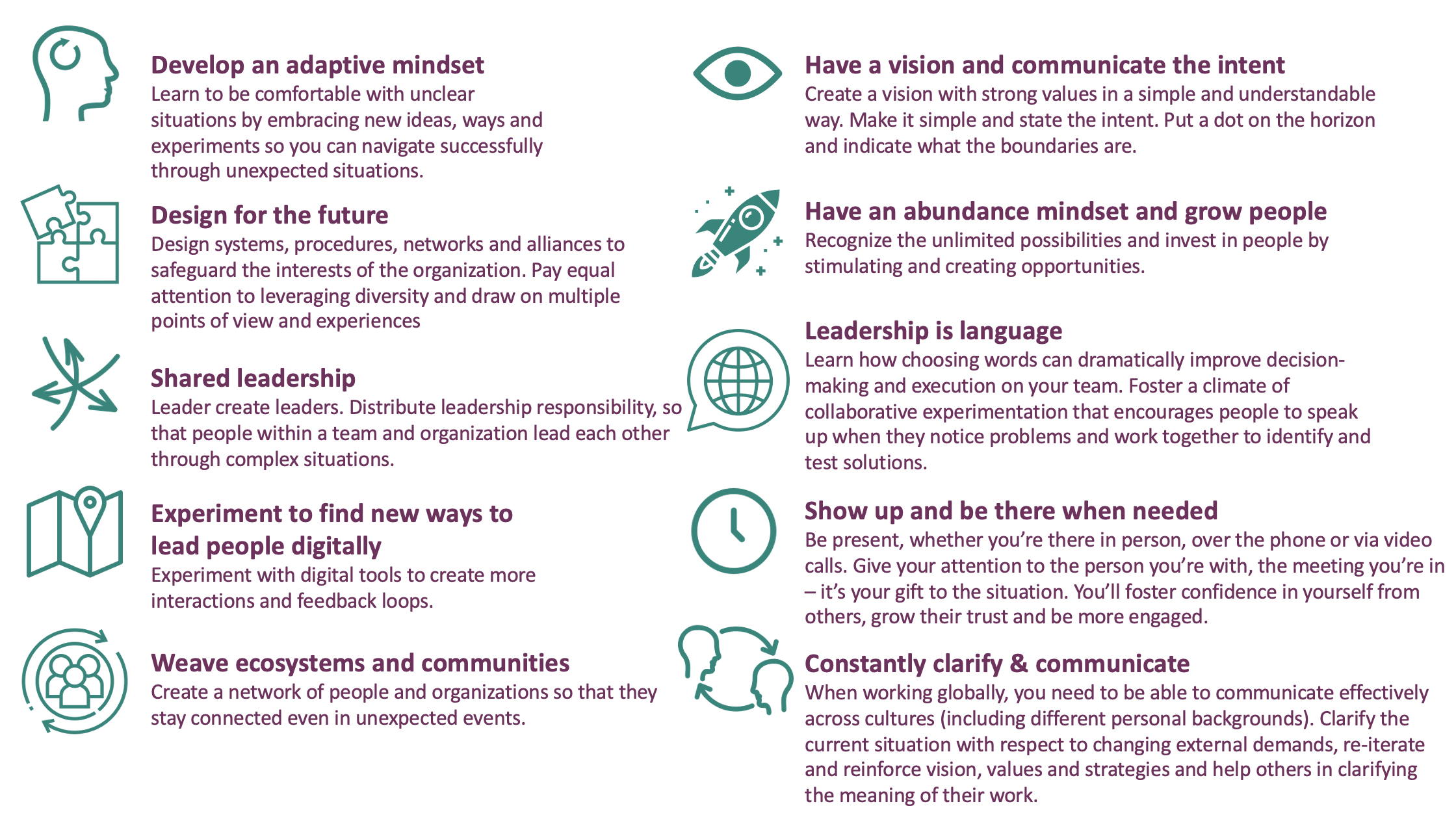The world is changing due to extreme events like a pandemic. The purpose of leadership therefore needs to change accordingly. The natural response to a crisis is often the opposite of leadership. With fear as a counselor, we can see a reversion to traditional control and processes. The underlying cause of this is the need for safety and security. Precisely during extreme events leaders can make the difference. In these events the market and employees need different forms of stimulation and support.

In previous crises, some organizations started something that others would advise against. The leadership in these organizations showed characteristics that contributed to these organizations being successful even in extreme situations.
‘An executive is a teacher; most people don’t think of him that way, but that’s what he is. He can’t do very much unless he can teach people. ... You can’t just pick out people and stick them in a job and say go ahead and do it. You’ve got to give them a philosophy to work against, you’ve got to state the goals, you’ve got to indicate the limitations and the methods.’ (Wolf, 1973, pp. 7-8).
Shortcuts in extreme situations that turn against leadership
During an extreme situation you often see path-goal leadership. Something needs to be done in a short time - such as emergencies and complicated situations in which there is a time constraint. The assumption is that the group members do not know what is good for them. Usually this works only in the short run and leads to worse performance in the long run. The question is: can you apply it in the right amount?
21st century leadership
So, what is the best leadership in the 21th century and are they successful? To properly understand leadership and its purpose, it is good to look at a number of existing theories [1]:
- Great Man Theory (1840s); great leaders as those who are destined by birth to become a leader. Furthermore, the belief was that great leaders will rise when confronted with the appropriate situation.
- Trait theory (1930s); believes that people are either born or are made with certain qualities that will make them excel in leadership roles.
- Behavioral (1940s); a new perspective, one that focuses on the behaviors of the leaders as opposed to their mental, physical or social characteristics (among other things: Role theory)
- Contingency (1960s); there is no single way of leading and that every leadership style should be based on certain situations, which signifies that there are certain people who perform at the maximum level in certain places; but at minimal performance when taken out of their element. (among other things: Hersey-Blanchard Situational Leadership Theory, Path-goal theory, Vroom-Yetton-Jago decision-making model of leadership, etc.)
- Transactional (1970s); known as exchange theories of leadership, are characterized by a transaction made between the leader and the followers. In fact, the theory values a positive and mutually beneficial relationship.
- Transformational (1970s); The Transformational Leadership theory states that this process is by which a person interacts with others and is able to create a solid relationship that results in a high percentage of trust, that will later result in an increase of motivation, both intrinsic and extrinsic, in both leaders and followers.

The transactional and transformational theories [2] are currently considered as the new leadership styles. The transformational style has been associated with significant benefits for organizations. However, it will not be suited to all circumstances. In some cases, leaders are not needed at all and leadership substitutes can be equally effective.
There is no one size fits all. Furthermore, there are dozens of derivatives or combinations of these theories. Although some elements of these theories are successful in organizations, it doesn’t seem to be doing much in general to improve the quality of leadership in most organizations. The world around us changes faster and situations are more extreme but still leadership is applying theories from a different era.
The new purpose of leaders is to ensure that new futures are created as rapidly as their external markets evolve. All organizations now have two equally important tasks: to deliver today’s results and to create the future.
Leadership must go beyond deciding the right thing to do and getting it done. Or is it just doing the right thing for the customers, organization and people?
Leadership Agility of the 21th century consists of 3 main qualities:
- How many leadership styles can you apply to lead effectively?
- Can you apply them at the right time when they are most effective?
- Can you learn new leadership styles? In order to prepare yourself if the situation demands it.

Finding the sweet spot and balance between these three will lead to an effective leader. From this position leaders can create leaders by doing the right micro-interventions [3].
Long-distance Leadership
The current pandemic has accelerated digitization. People are forced to work from home with the computer and telephone as their only means of communication. As a leader you speak to people less often, which reduces social contact, and everything has to be scheduled.
Mastering long-distance leadership is one of the styles to be added to the leadership palette. This style is important not only now, but also in the future. Long-distance leadership has limitations and opportunities. In order to lead a team from afar keep these 10 skills in mind [4][5][6].

Next
Leadership and its purpose have changed in the 21th century. The world has become complex and uncertain. Unexpected events like a pandemic event have proven this. The good thing is that you can prepare for it. Focus on the 3 main qualities of Leadership Agility and keep the 10 skills of long-distance leadership in mind.
References
[1] Leadership Central, Leadership Theories, leadership-theories
[2] Bass, ed. by Bruce J. Avolio & Bernard M. (2002). Developing potential across a full range of leaderships : cases on transactional and transformational leadership. Mahwah, NJ [u.a.]: Lawrence Erlbaum Associates. ISBN 978-0805838947.
[3] Rik de Groot), Agile NXT: Micro-Interventions from a Position of Leadership, Xebia
[4] Stephen R. Covey, 7 Habits Of Highly Effective People, EAN 9781451639612
[5] Peter Hinsen, The network always wins: hoe overleven in een onzeker tijdperk, ISBN 9789401427258
[6] David Marquet, Leadership Is Language The Hidden Power of What You Say and What You Don't, EAN 9780241373668
Do you want to know more about this topic?
Join us for the free Webinar: Strategy to survive: Shifting organizational leadership on Sept 11, 2020, 10 am.






